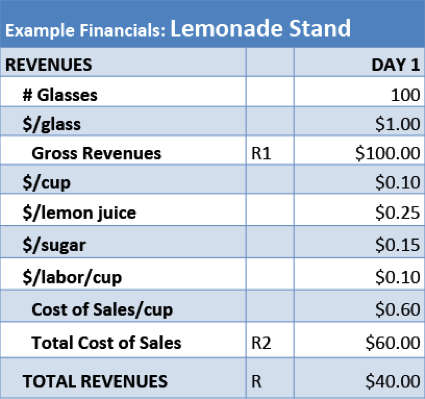A viable plan?
Before spending any effort building a spreadsheet, I always recommend creating a “back of the envelope” calculation to quickly understand whether the business has any chance of being viable and whether, “at scale,” the business looks big enough to be worth spending time on.
For the lemonade stand, we can put all the values into a table:
We guessed at how many units will be sold. 100 glasses per day is a nice, round, reasonable-size number of sales that helps demonstrate how this business works.
What this calculation shows is that for every 100 glasses, the business earns a “top-line” revenue (a.k.a. “gross” revenue) of $100, but a “net revenue” of just $40. The variable expenses are sixty cents per cup. This calculation shows that for every 100 glasses, $60 of supplies and labor are needed. Like most cost of goods, most of that money is needed up front, before the business opens its doors.
If I were a child told I could make $40 selling lemonade, that would get me excited. However, if I were a sophisticated child and understood that I needed to spend $60 of my cash to make $100, earning a $40 profit, I may be far less excited.
This is important, so let me say it in another way. What we can learn from this simple back-of-the-envelope calculation is that, in this lemonade business, we need to invest $60 up front for every $100 in revenue, and of that $100, we then get our $60 back plus $40 in profits.
Compared to the stock market, that is a great investment, but only if we have $60 to invest and only if it works out as planned. In reality, two important details are missing.
First, we have not accounted for any fixed costs yet. We need a table, a pitcher, and a spoon for making and selling the lemonade. If we want to sell more than $100 in lemonade, we probably need a sign plus perhaps some flyers or other marketing materials. In any real-life company, there are quite a few of these “fixed” costs that need to be paid for before we can start selling anything.
Second, the plan may be wrong. Perhaps we’ll sell just fifty glasses in a day, in which case the total revenues will be $50, the cost of goods $30, and the profits $20. Do we still want to work all day for $20 in profits? Worse, given our plan of selling 100 glasses, we may have purchased $60 worth of goods, sold only $50, and lost $10 for the day.
When putting together your back-of-the-envelope financial plan, ask yourself, “What could go wrong?”












